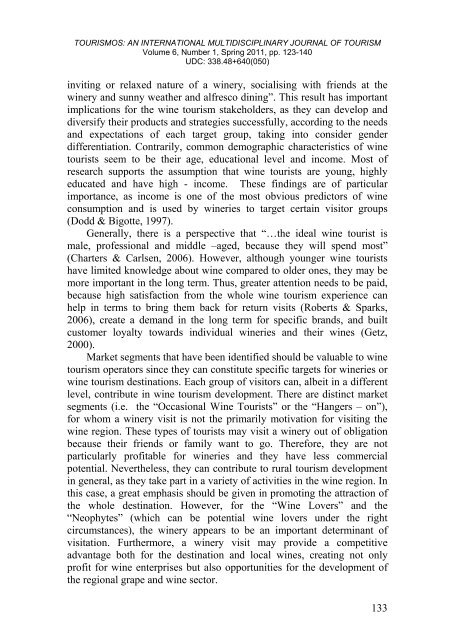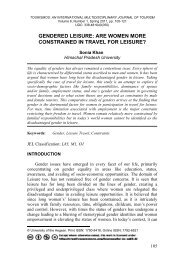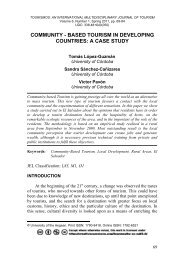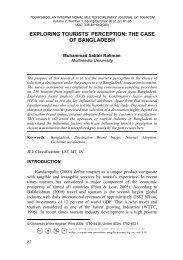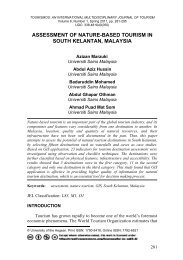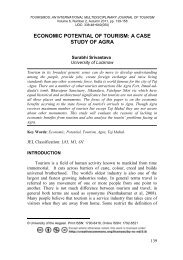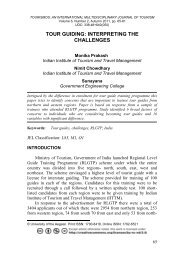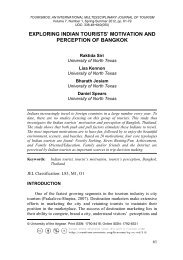TOURISMOS is an international, multi-disciplinary, refereed (peer ...
TOURISMOS is an international, multi-disciplinary, refereed (peer ...
TOURISMOS is an international, multi-disciplinary, refereed (peer ...
You also want an ePaper? Increase the reach of your titles
YUMPU automatically turns print PDFs into web optimized ePapers that Google loves.
<strong>TOURISMOS</strong>: AN INTERNATIONAL MULTIDISCIPLINARY JOURNAL OF TOURISM<br />
Volume 6, Number 1, Spring 2011, pp. 123-140<br />
UDC: 338.48+640(050)<br />
inviting or relaxed nature of a winery, social<strong>is</strong>ing with friends at the<br />
winery <strong>an</strong>d sunny weather <strong>an</strong>d alfresco dining”. Th<strong>is</strong> result has import<strong>an</strong>t<br />
implications for the wine tour<strong>is</strong>m stakeholders, as they c<strong>an</strong> develop <strong>an</strong>d<br />
diversify their products <strong>an</strong>d strategies successfully, according to the needs<br />
<strong>an</strong>d expectations of each target group, taking into consider gender<br />
differentiation. Contrarily, common demographic character<strong>is</strong>tics of wine<br />
tour<strong>is</strong>ts seem to be their age, educational level <strong>an</strong>d income. Most of<br />
research supports the assumption that wine tour<strong>is</strong>ts are young, highly<br />
educated <strong>an</strong>d have high - income. These findings are of particular<br />
import<strong>an</strong>ce, as income <strong>is</strong> one of the most obvious predictors of wine<br />
consumption <strong>an</strong>d <strong>is</strong> used by wineries to target certain v<strong>is</strong>itor groups<br />
(Dodd & Bigotte, 1997).<br />
Generally, there <strong>is</strong> a perspective that “…the ideal wine tour<strong>is</strong>t <strong>is</strong><br />
male, professional <strong>an</strong>d middle –aged, because they will spend most”<br />
(Charters & Carlsen, 2006). However, although younger wine tour<strong>is</strong>ts<br />
have limited knowledge about wine compared to older ones, they may be<br />
more import<strong>an</strong>t in the long term. Thus, greater attention needs to be paid,<br />
because high sat<strong>is</strong>faction from the whole wine tour<strong>is</strong>m experience c<strong>an</strong><br />
help in terms to bring them back for return v<strong>is</strong>its (Roberts & Sparks,<br />
2006), create a dem<strong>an</strong>d in the long term for specific br<strong>an</strong>ds, <strong>an</strong>d built<br />
customer loyalty towards individual wineries <strong>an</strong>d their wines (Getz,<br />
2000).<br />
Market segments that have been identified should be valuable to wine<br />
tour<strong>is</strong>m operators since they c<strong>an</strong> constitute specific targets for wineries or<br />
wine tour<strong>is</strong>m destinations. Each group of v<strong>is</strong>itors c<strong>an</strong>, albeit in a different<br />
level, contribute in wine tour<strong>is</strong>m development. There are d<strong>is</strong>tinct market<br />
segments (i.e. the “Occasional Wine Tour<strong>is</strong>ts” or the “H<strong>an</strong>gers – on”),<br />
for whom a winery v<strong>is</strong>it <strong>is</strong> not the primarily motivation for v<strong>is</strong>iting the<br />
wine region. These types of tour<strong>is</strong>ts may v<strong>is</strong>it a winery out of obligation<br />
because their friends or family w<strong>an</strong>t to go. Therefore, they are not<br />
particularly profitable for wineries <strong>an</strong>d they have less commercial<br />
potential. Nevertheless, they c<strong>an</strong> contribute to rural tour<strong>is</strong>m development<br />
in general, as they take part in a variety of activities in the wine region. In<br />
th<strong>is</strong> case, a great emphas<strong>is</strong> should be given in promoting the attraction of<br />
the whole destination. However, for the “Wine Lovers” <strong>an</strong>d the<br />
“Neophytes” (which c<strong>an</strong> be potential wine lovers under the right<br />
circumst<strong>an</strong>ces), the winery appears to be <strong>an</strong> import<strong>an</strong>t determin<strong>an</strong>t of<br />
v<strong>is</strong>itation. Furthermore, a winery v<strong>is</strong>it may provide a competitive<br />
adv<strong>an</strong>tage both for the destination <strong>an</strong>d local wines, creating not only<br />
profit for wine enterpr<strong>is</strong>es but also opportunities for the development of<br />
the regional grape <strong>an</strong>d wine sector.<br />
133


